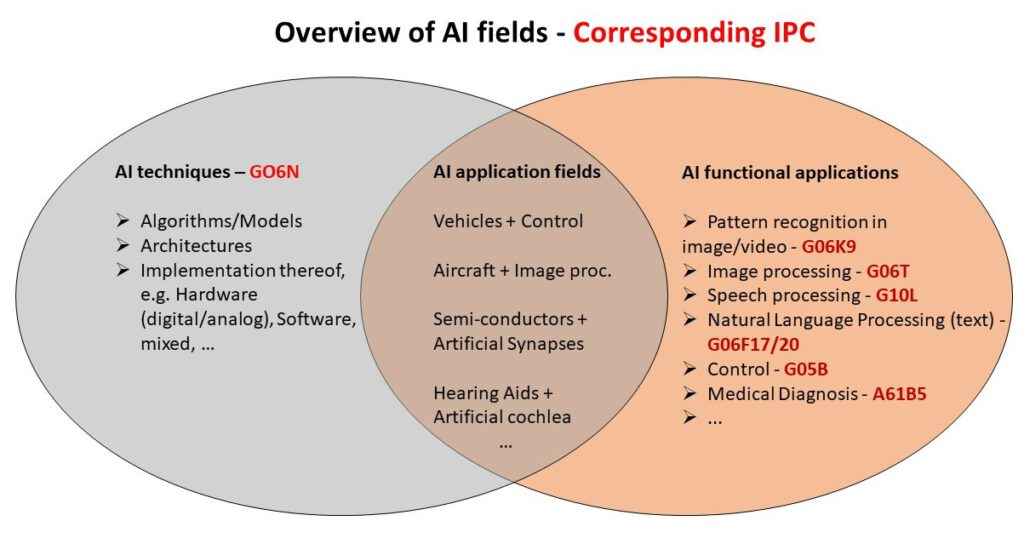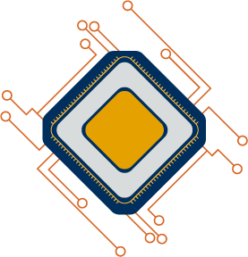Inventions in the field of Artificial Intelligence encompasses computational systems with capabilities and/or behaviour commonly perceived as “intelligent” by humans. In general, the same criteria as for computer-implemented inventions are applied to this type of invention at the European Patent Office. Specific information on AI inventions is provided below. The information is based on the EPO guidelines, among others.
Different types of AI inventions
AI inventions can generally be divided into three groups: “AI techniques”, “AI functional applications”, and “AI application fields”.
AI techniques are (acc. Association for Computer Machinery (ACM)):
advanced forms of statistical and mathematical models, such as machine learning, fuzzy logic and expert systems, allowing the computation of tasks typically performed by humans; different AI techniques may be used as a means to implement different AI functions.
AI functional applications are (acc. ACM):
functions such as speech or computer vision which can be realized using one or more AI techniques.
AI application fields are (acc. ACM):
different fields, areas or disciplines where AI techniques or functional applications may find application, such as transportation, agriculture or life and medical sciences.
Inventions in the field of AI techniques and AI functional applications – i.e. core machine learning applications – develop the field of machine learning itself. These techniques and applications can be used across many different technological fields, i.e. AI application fields.
Examples of the AI groups
A brief overview of some examples of inventions in AI techniques, AI functional applications, and AI application fields are shown in the figure below including the relevant International Patent Classification (IPC):

Class G06N is sometimes referred to as ‘core AI’. G06K9 (more recently G06V) is commonly referred to as (image-based) pattern recognition. There have also been patent applications in AI for decades, for example in pattern recognition G06K9, image processing G06T, speech recognition G10L or natural language processing G06F40 (formerly G06F17/20).
AI considered as mathematical method
In general, subject matter regarding artifical intelligence is considered to be a mathematical method. It is excluded from patentability under Art. 52(2)(a) when claimed as such (Art. 52(3)), please see also CII @ the EPO, chapter (1).
The exclusion applies if a claim is directed to a purely abstract mathematical method and the claim does not require any technical means.
For instance, a method for performing a Fast Fourier Transform on abstract data which does not specify the use of any technical means is a mathematical method as such.
A purely abstract mathematical object or concept, e.g. a particular type of geometric object or of graph with nodes and edges, is not a method but is nevertheless not an invention within the meaning of Art. 52(1) because it lacks a technical character.
Technical character of a mathematical method
If a claim is directed either to a method involving the use of technical means (e.g. a computer) or to a device, its subject-matter has a technical character as a whole and is thus not excluded from patentability under Art. 52(2) and (3), please see also CII @ the EPO, chapter (2).
Novelty and inventive step re a mathematical method
Once it is established that the claimed subject-matter as a whole is not excluded from patentability under Art. 52(2) and (3) and is thus an invention within the meaning of Art. 52(1), it is examined in respect of the other requirements of patentability, in particular novelty and inventive step.
For the assessment of inventive step, all features which contribute to the technical character of the invention must be taken into account, please see also CII @ the EPO, chapter (3). When the claimed invention is based on a mathematical method, it is assessed whether the mathematical method contributes to the technical character of the invention.
Contribution to the technical character
A mathematical method may contribute to the technical character of an invention, i.e. contribute to producing a technical effect that serves a technical purpose, by its application to a field of technology and/or by being adapted to a specific technical implementation (T 2330/13), please see also especially CII @ the EPO, chapter (7) and chapter (9). These two preconditions can be designated as “two dimensions to contribute to the technical character” (please see presentation of the EPO Examiners Markus Vollmer and Jean-Marc Deltorn at the “Examination Matters 2019”):

The criteria for assessing these two dimensions are shown in the further chapters (2) to (4).
